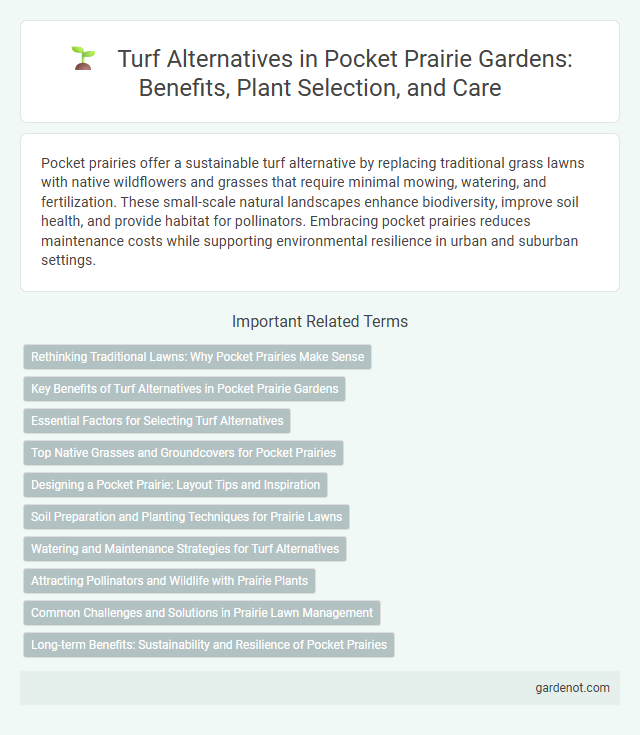Pocket prairies offer a sustainable turf alternative by replacing traditional grass lawns with native wildflowers and grasses that require minimal mowing, watering, and fertilization. These small-scale natural landscapes enhance biodiversity, improve soil health, and provide habitat for pollinators. Embracing pocket prairies reduces maintenance costs while supporting environmental resilience in urban and suburban settings.
Rethinking Traditional Lawns: Why Pocket Prairies Make Sense
Pocket prairies provide an eco-friendly turf alternative by supporting native plants that improve biodiversity and require less maintenance than traditional lawns. By encouraging deep-rooted grasses and wildflowers, pocket prairies enhance soil health and reduce water usage significantly. This sustainable landscaping approach aligns with environmental goals while offering a visually appealing and resilient green space.
Key Benefits of Turf Alternatives in Pocket Prairie Gardens
Turf alternatives in pocket prairie gardens promote biodiversity by providing habitat for pollinators and beneficial insects, enhancing ecological balance. These options reduce water consumption and maintenance costs compared to traditional lawns, supporting sustainable gardening practices. Moreover, turf alternatives improve soil health and prevent erosion through diverse root systems that stabilize the ground.
Essential Factors for Selecting Turf Alternatives
Choosing a turf alternative involves evaluating factors such as soil type, water availability, and climate adaptability to ensure sustainable growth. Native plants and drought-tolerant species reduce maintenance, water use, and chemical inputs while promoting local biodiversity. Cost-effectiveness, aesthetic appeal, and resistance to pests and diseases are critical considerations for a successful pocket prairie implementation.
Top Native Grasses and Groundcovers for Pocket Prairies
Top native grasses such as Little Bluestem (Schizachyrium scoparium), Indian Grass (Sorghastrum nutans), and Switchgrass (Panicum virgatum) provide essential structure and drought tolerance in pocket prairies. Groundcovers like Wild Strawberry (Fragaria virginiana) and Pennsylvania Sedge (Carex pensylvanica) create dense, low-maintenance mats that suppress weeds and reduce soil erosion. Choosing these species supports local biodiversity while minimizing turf replacement needs and maintenance efforts.
Designing a Pocket Prairie: Layout Tips and Inspiration
Design a pocket prairie by selecting native grasses and wildflowers that thrive in your local climate, creating a natural turf alternative that promotes biodiversity and reduces maintenance. Arrange plantings in clustered groups mimicking natural prairie patterns to enhance visual interest and support pollinators. Incorporate curved pathways and layered vegetation heights to optimize both aesthetics and ecological functions within the pocket prairie layout.
Soil Preparation and Planting Techniques for Prairie Lawns
Soil preparation for pocket prairie lawns involves deeply loosening compacted soil to improve water infiltration and root penetration. Incorporating organic matter such as compost enhances soil fertility and supports diverse native plant growth. Planting techniques prioritize using a mix of native prairie grasses and wildflowers, seeded at appropriate depths and densities to mimic natural prairie ecosystems and ensure resilient turf alternatives.
Watering and Maintenance Strategies for Turf Alternatives
Pocket prairies use drought-resistant native plants that require significantly less watering compared to traditional turfgrass, promoting water conservation in landscaping. Maintenance strategies for turf alternatives focus on periodic mowing and selective weeding rather than frequent watering and fertilizing, reducing labor and resource inputs. These practices enhance ecosystem health while providing a sustainable, low-maintenance landscape solution that supports biodiversity.
Attracting Pollinators and Wildlife with Prairie Plants
Pocket prairies serve as effective turf alternatives by incorporating native prairie plants that attract diverse pollinators such as bees, butterflies, and hummingbirds. These plants provide essential nectar and pollen sources, enhancing local biodiversity and supporting wildlife habitats in urban environments. Using prairie species encourages sustainable landscaping practices while promoting ecological balance and resilience.
Common Challenges and Solutions in Prairie Lawn Management
Managing a pocket prairie as a turf alternative often involves challenges such as weed invasion, uneven plant establishment, and seasonal maintenance demands. Effective solutions include selecting region-specific native grasses and wildflowers for better adaptability, implementing targeted mowing regimes to suppress weeds and encourage native growth, and applying spot treatments rather than broad herbicide use to preserve biodiversity. Integrating soil health practices like aeration and organic mulching further supports resilient prairie lawns with reduced need for water and chemical inputs.
Long-term Benefits: Sustainability and Resilience of Pocket Prairies
Pocket prairies provide a sustainable turf alternative by enhancing biodiversity and improving soil health, which reduces maintenance requirements compared to traditional lawns. Their deep-rooted native plants increase water retention and resilience against drought, minimizing irrigation needs and mitigating urban heat island effects. Over time, pocket prairies support carbon sequestration, promote pollinator habitats, and contribute to long-term ecological balance in urban landscapes.
Turf alternative Infographic

 gardenot.com
gardenot.com